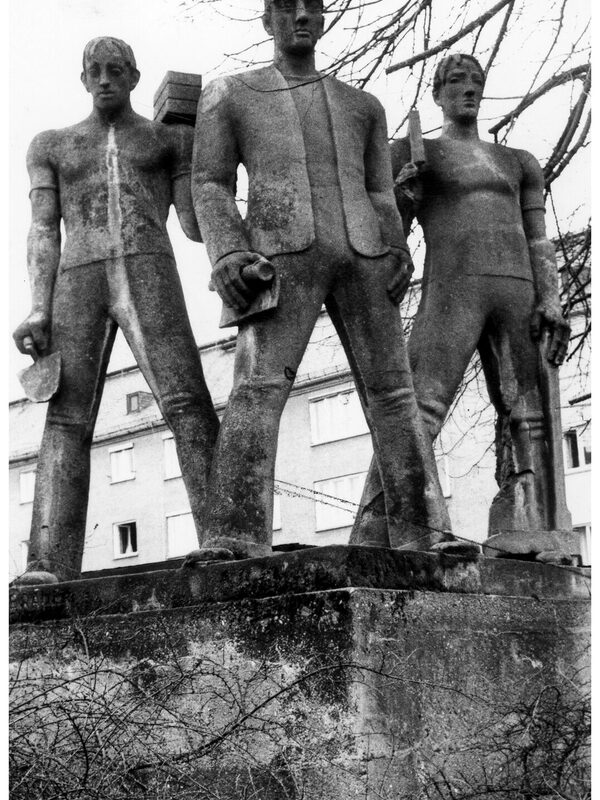Monument to Labor (Workers' Monument)
The "Monument to Labor", also known as the Workers' Monument, was created in 1932 by the artist Carl Wilhelm Bierbrauer (1881-1962) on behalf of the city of Wiesbaden. It was created on the then edge of the Rheingau district, which was extended between 1926 and 1928 as part of social housing construction. Stylistically, the sculpture reflects the workers' movement at the beginning of the 20th century.
The Rheingauviertel was extended between 1926 and 1928 as part of social housing construction. In the course of this work, it was given characteristic streets that differed from the classic, densely populated working-class districts. The newly built apartment blocks were generously laid out. Lightless, narrow, dreary backyards and low entrances for service personnel gave way to unstructured facades and high entrances. The architecture of the social housing emphasized the social equality of the residents. This was also artistically emphasized and underlined by the "Monument to Work".
The sculpture was created in 1932 by Wiesbaden artist Carl Wilhelm Bierbrauer (opens in a new tab) (1881-1962). Stylized workers stand on a block of stone in the style of realism. The figures are upright, powerful and athletic. They are holding a trowel, building plan and axe. The artist thus refers to the self-confidence of the working class during the Weimar Republic. At the same time, he transcends the formal language of realism by idealizing the shapes of the bodies. He depicts the figures with large, "gripping" hands and a broad, firm stance. Bierbrauer simplified the body forms into conical, powerful elements. In their alignment and frontal position, they are reminiscent of soldiers.
The figure on the right is holding a rope hanging over his shoulder and an axe rests on his left side. It represents a carpenter. The figure on the left can be recognized as a bricklayer by the trowel and shouldered brick. The figure in the middle is facing forward, holding a construction drawing in his right hand and, unlike the other two depictions, is wearing a jacket. He can be recognized as an engineer. Apart from their attributes and minor differences in clothing and hair, the figures are not further individualized. The uniform, very similar facial features are particularly striking.
The "Monument to Labor" was severely damaged during the Second World War. After the war, the Wiesbaden sculptor Peter Dienstdorf (1893-1976) was commissioned to reconstruct the sculpture according to Bierbrauer's plans. The original state could thus be restored.
In addition to the monument on Loreleiring, numerous other works of art on public buildings can be attributed to Carl Wilhelm Bierbrauer. For example, he created the frieze on the portico of the mourning hall at the South Cemetery (1909) and the Gutenberg monument in front of the University and State Library (1911) in Rheinstraße. He is thus one of the Wiesbaden artists who have left their mark on the cityscape.
Carl Wilhelm Bierbrauer was born in Bierstadt in 1881. He trained as a visual artist at the Städelsches Kunstinstitut in Frankfurt am Main. His teachers included Ferdinand Luthmer (1842-1921), director of the Kunstgewerbeschule and the Kunstgewerbemuseum Frankfurt am Main, and Friedrich Christoph Hausmann (1860-1936), an Austrian artist and sculptor. After completing his studies, Bierbrauer returned to Wiesbaden and taught at the Wiesbaden Werkkunstschule from 1913 to 1933. In addition to his teaching activities, he worked as a freelance artist with his own studio in Frankfurter Straße.
In 1915, he created the so-called "Iron Siegfried" made of lime wood, which was first erected in Wilhelmstraße and then in the town hall. The figure was intended to appeal to the Germans' sense of sacrifice in the First World War and to encourage donations for war widows and war orphans. In 1931, Bierbrauer won the competition for the Reich Memorial in Bad Berka. He prevailed against 1,826 competitors. However, the memorial was never realized. After 1933, Bierbrauer worked entirely as a freelance artist. During this time, he created a bust of Adolf Hitler (1934) for the lobby of the Wiesbaden Kurhaus. In 1939, he created a memorial for the Erbenheim air base. The monumental sculpture, which shows a golden eagle on a block with a shield, now stands at the entrance to the US Army air base in Erbenheim. His work on the Hospiz zum Heiligen Geist has not survived. The building was demolished in 1969.
The Wiesbaden artist also received further commissions after 1945. He created the bust of Baron vom Stein for the town hall foyer (1952). Bierbrauer was also active on the board of the Nassau Art Association and the Ring of Visual Artists.
Literature
Buchholz, Denkmäler, pp. 122-127; Hildebrand, Alexander: Das Porträt. Carl Wilhelm Bierbrauer. In: Wiesbaden international 2/1981 [pp. 27-35].
